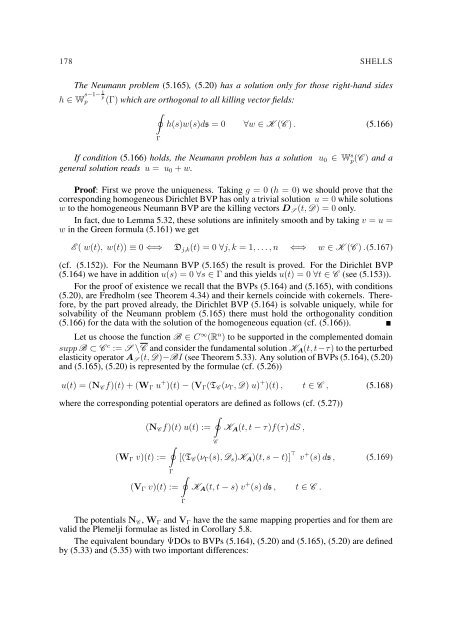EQUATIONS OF ELASTIC HYPERSURFACES
EQUATIONS OF ELASTIC HYPERSURFACES
EQUATIONS OF ELASTIC HYPERSURFACES
You also want an ePaper? Increase the reach of your titles
YUMPU automatically turns print PDFs into web optimized ePapers that Google loves.
178 SHELLS<br />
The Neumann problem (5.165), (5.20) has a solution only for those right-hand sides<br />
h ∈ W s−1− 1 p<br />
p (Γ) which are orthogonal to all killing vector fields:<br />
∮<br />
h(s)w(s)ds = 0 ∀w ∈ K (C ) . (5.166)<br />
Γ<br />
If condition (5.166) holds, the Neumann problem has a solution u 0 ∈ W s p(C ) and a<br />
general solution reads u = u 0 + w.<br />
Proof: First we prove the uniqueness. Taking g = 0 (h = 0) we should prove that the<br />
corresponding homogeneous Dirichlet BVP has only a trivial solution u = 0 while solutions<br />
w to the homogeneous Neumann BVP are the killing vectors D S (t, D) = 0 only.<br />
In fact, due to Lemma 5.32, these solutions are infinitely smooth and by taking v = u =<br />
w in the Green formula (5.161) we get<br />
E ( w(t), w(t)) ≡ 0 ⇐⇒ D j,k (t) = 0 ∀j, k = 1, . . . , n ⇐⇒ w ∈ K (C ) .(5.167)<br />
(cf. (5.152)). For the Neumann BVP (5.165) the result is proved. For the Dirichlet BVP<br />
(5.164) we have in addition u(s) = 0 ∀s ∈ Γ and this yields u(t) = 0 ∀t ∈ C (see (5.153)).<br />
For the proof of existence we recall that the BVPs (5.164) and (5.165), with conditions<br />
(5.20), are Fredholm (see Theorem 4.34) and their kernels coincide with cokernels. Therefore,<br />
by the part proved already, the Dirichlet BVP (5.164) is solvable uniquely, while for<br />
solvability of the Neumann problem (5.165) there must hold the orthogonality condition<br />
(5.166) for the data with the solution of the homogeneous equation (cf. (5.166)).<br />
Let us choose the function B ∈ C ∞ (R n ) to be supported in the complemented domain<br />
supp B ⊂ C c := S \C and consider the fundamental solution K A (t, t−τ) to the perturbed<br />
elasticity operator A S (t, D)−BI (see Theorem 5.33). Any solution of BVPs (5.164), (5.20)<br />
and (5.165), (5.20) is represented by the formulae (cf. (5.26))<br />
u(t) = (N C f)(t) + (W Γ u + )(t) − (V Γ (T C (ν Γ , D) u) + )(t) , t ∈ C , (5.168)<br />
where the corresponding potential operators are defined as follows (cf. (5.27))<br />
∮<br />
(N C f)(t) u(t) := K A (t, t − τ)f(τ) dS ,<br />
∮<br />
(W Γ v)(t) :=<br />
C<br />
[(T C (ν Γ (s), D s )K A )(t, s − t)] ⊤ v + (s) ds , (5.169)<br />
Γ<br />
∮<br />
(V Γ v)(t) :=<br />
K A (t, t − s) v + (s) ds , t ∈ C .<br />
Γ<br />
The potentials N C , W Γ and V Γ have the the same mapping properties and for them are<br />
valid the Plemelji formulae as listed in Corollary 5.8.<br />
The equivalent boundary ΨDOs to BVPs (5.164), (5.20) and (5.165), (5.20) are defined<br />
by (5.33) and (5.35) with two important differences:

















